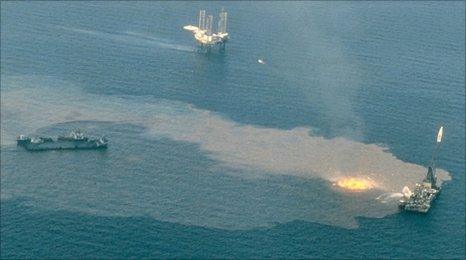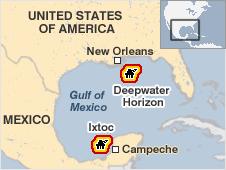Mexicans still haunted by 1979 Ixtoc spill
- Published

The Ixtoc well was drilling at 150ft compared with Deepwater Horizon at 5,000ft
If the worried inhabitants of the southern coast of the US wonder what long-term effects the BP oil spill will have on their livelihoods and the environment, they could come to the Mexican state of Campeche to find answers.
An explosion in 1979 at the Ixtoc I platform, located 80km (50 miles) off Mexico's Gulf Coast, caused the largest ever peacetime oil spill.
It took Pemex, Mexico's state-owned oil company, more than nine months to stop the leak, during which time almost 3.3 million barrels of oil had gushed into the sea. It travelled as far as the Texas shoreline.
The fire and collapse of the Ixtoc rig is eerily similar to what happened at Deepwater Horizon: in both cases, the blowout preventer failed to function.
Back in 1979, Pemex tried several methods to contain the oil that were similar to the procedures recently used by BP.
They finally managed to stop it by drilling two relief wells.
A crucial difference is that the Ixtoc was drilling at a depth of 150ft (45m), whilst Deepwater blew at 5,000 ft (1.5km) below the sea.
But, as the people of Campeche have learnt, blocking the leak is not necessarily the biggest challenge when an oil spill occurs.
Uncertain impact
In the fishing town of Champoton, in the state of Campeche, many people will tell you that the Ixtoc spill marked a turning point in the economy of the area.
"The amount of fish to catch was never the same as before the spill," says Pablo Bonastre, a veteran fisherman who still remembers the days after the accident when they would catch fish whose eyes were red and almost popping out.
And he vividly recalls the local government giving them "a pair of boots, a spade and plastic bags" to help collect the oil from the sea's surface.
In the following months, many fishermen had to find unskilled work on land; others left town and never returned.
The fishermen believe that depleted fish stocks are not just the result of the Ixtoc spill but of pollution caused by the area's burgeoning oil industry, which has helped make Mexico one of the world's top 10 oil producers.
The wider environmental impact of the Ixtoc oil spill is uncertain.
A series of studies have argued that several factors reduced that impact considerably, among them, the high sea temperatures, which helped the oil evaporate, and the sea currents in the area.

Traces from the Ixtoc oil spill allegedly still remain on Mexico's coastline
A 1985 report by Mexico's National Autonomous University concluded that the effect of the spill was limited.
The Ixtoc spill, it explains, "despite being of great proportions did not (...) cause the deadly environmental impact over the diverse communities and elements that make up the Campeche Sound."
But another study, carried out by Swedish researchers in 1981, appears to contradict that view.
"The oil from the Ixtoc I blow-out acutely affected the species and ecosystems in the Campeche Bay area through its chemical toxicity (in the vicinity of the well) and through its physical properties (stickiness) in a larger area offshore and along the coast," that study says.
Beyond the academic debate, locals are adamant that the most obvious evidence of Ixtoc's legacy are the black, rock-like formations of solidified oil that can be found in parts of the Campeche coast.
Those were not here before the Ixtoc spill, they say.
'Only solution'
Many in Mexico believe that the Ixtoc episode could not only provide clues to the possible effects of the BP oil slick, but also offer more immediate guidance.

At the time of the Ixtoc crisis, Carlos Osornio was the chief offshore drilling engineer for Pemex and was part of the team trying to contain the leak.
From those moments of tension and uncertainty he has this advice for the engineers at BP.
"My recommendation would be to build two relief wells," he told the BBC. "It is the only and final solution they have."
No doubt those efforts to stop the flow of oil will be followed closely by the residents of the Campeche coast.
They fear that a busy hurricane season and changing currents could push some of the oil leaking from the BP rig to their shores - bringing with it the painful memories of Ixtoc, 30 years on.
You can listen to Does Nature Recover, Rajesh Mirchandani's report from Mexico, on World Service Radio at 1100GMT, or watch it on BBC World News at 1100GMT on Monday 14 June.